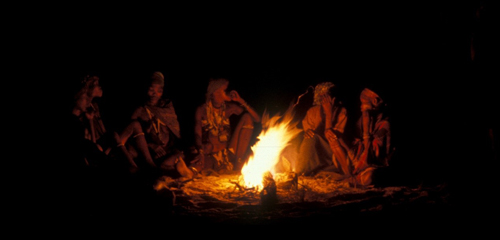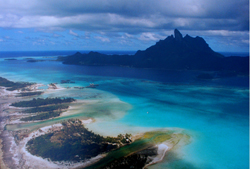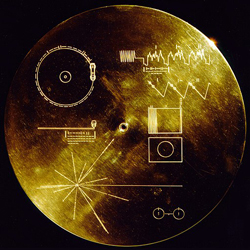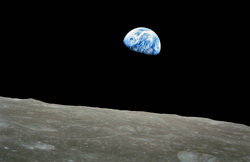Matthieu Galvez argues that carbon is key to defining our planet. Not only does this element link the solid, fluid and biological components of Earth, it is also centre-stage in the ethical dilemmas faced by humankind.
Galvez, M. E., Finding Earth.
Geoscientist 29 (1), 16-19, 2019
https://doi.org/10.1144/geosci2019-004; Download the pdf here
When the physicist Erwin Schrödinger wrote his masterpiece “what is life?” (Schrödinger, 1944), he made it his mission to solve a long-standing paradox of humankind. We all have an intuition about what life is, and yet it is utterly difficult to define. We face a similar issue with Earth today.
What is Earth?
Ask any scientist “what is Earth?” and you may be in for a surprise. I asked astronomer Xavier Dumusque who said with a smile “Earth is a sinusoidal signal in velocity with a period of a year, and an amplitude of 10 cm/s”. Amar Vutha, an atomic physicist calls it “an astronomical body whose surface, amazingly, seems to contain almost every atom from the periodic table”. For evolutionary plant biologist Patrick Shih, Earth has been a “home for the evolution of life for more than 3 billion years”. Ethicist Vanessa Rampton flips the perspective and says it is a place where “human freedom leads us to wonder at the laws of physics and biology while asking why?”
The geoscientist’s approach is to characterize the planet in search of distinctive traits. They ask for example: why are mineral resources so rare and unevenly distributed in continents? What controls the shape of mountains and of the seafloor, and the periodic oscillations of climate over decades to millions of years? Could the structure and rhythms of our planet be unique in the Solar System? To build the grand genealogy of our world, geoscientists seek traces of the past and the origins of everything we see: continents, the magnetic field, ice-caps, soils, and the minerals of the deep mantle and core. Geoscientists give them a name, a date, and they sort the dates into chronological order. The result is anything but a clear-cut definition; on the contrary, we find Earth increasingly difficult to define.
 Embers of society. Humankind has pondered the meaning of everything we see around us, and built all sorts of narratives about it, since its very origins. Anthropologist Polly Wiessnerstudies the stories told by the Ju/’hoansi Bushmen (Wiessner, PNAS 2014). Storytelling related to our successes and failures, as well as to the meaning of the environment that surrounds us, may have started at night, around the campfire. Image credit: Polly Wiessner
Embers of society. Humankind has pondered the meaning of everything we see around us, and built all sorts of narratives about it, since its very origins. Anthropologist Polly Wiessnerstudies the stories told by the Ju/’hoansi Bushmen (Wiessner, PNAS 2014). Storytelling related to our successes and failures, as well as to the meaning of the environment that surrounds us, may have started at night, around the campfire. Image credit: Polly Wiessner
A changing planet
One reason Earth is tricky to define is because it is a dynamic planet, subject to all kinds of transformations at all scales (Anderson, Science 1984). This means that almost everything around us—glaciers, atmospheric oxygen, soils and even the continents—has a beginning and an end. The ice-cap of Antarctica, for example, grew only recently, about 40-30 million years ago. This event dried out shallow seas in nearby continents, including parts of South America where Amazonia has become the hotspot of biodiversity that we know today. Even soils composed of organic matter and minerals did not exist before algae and plants with roots conquered the terrestrial environment 500-300 million years ago (Fischer, Science 2018).
There are all kinds of changes on Earth. Some are subject to reversal, some are permanent. Although reversible changes in fluxes of geological materials that control climate, for example, are those we are most familiar with, Earth does irreversibly cool and oxidize, slowly, and over long periods of time. Mars is now dead and red for this reason.
But not all changes on Earth are slow. Sometimes geological change can be surprisingly abrupt and disruptive. The cataclysmic eruption of Campi Flegrei, Italy, and the cascade of environmental perturbations it caused is thought to have knocked out Neanderthal tribes from Eastern Europe and from large swaths of Asia, about 40,000 years ago.
A living planet
Another reason Earth is difficult to define is that, in some ways, it is alive (Knoll, Geobiology 2003; Vignieri & Fahrenkamp-Uppenbrink, Science 2017; Lenton & Latour, Science 2018). Consider the abundance of liquid water (Campbell & Taylor, Geophys. Res. Lett. 1983), the longevity of plate tectonics, or the abundance and diversity of organic materials in contact with our atmosphere bathed in reactive O2 (Krissansen-Totton et al., Astrobiology 2016). These are some of Earth’s most distinctive traits, and yet they appear to be direct or indirect products of life (Falkowski et al., Science 2008). Ozone and O2 started to accumulate in the atmosphere about 2.4 to 2.3 billion years ago (Luo et al., Sci. Adv. 2016), shortly after the evolution of oxygenic bacteria (Fischer et al., Ann. Rev. Earth Planet. Sci. 2016) that produce dioxygen as a waste. As a result, water got locked on our planet, instead of slowly escaping to space (Catling et al., Science 2001) as it did on Venus (Chassefière, Icarus 1997; Driscoll & Bercovici, Icarus 2013). And because water is essential to sustaining active tectonics (Campbell & Taylor, Geophys. Res. Lett. 1983), our Planet’s peculiar dynamics, too, may be remotely linked to the longevity of photosynthetic life.
In the Anthropocene we, as a society, have become a geological force (Locher & Fressoz, Critical Inquiry 2012). The impacts of industrial activities and financial fluxes today include rapid atmospheric warming, and ocean acidification and deoxygenation (Gruber, Phil. Trans. Royal Soc. 2011)—the visible record of an anthropogenic acceleration in the geological flux of carbon (CO2).
The interaction between Earth and life goes both ways. Weathered continents provide the essential nutrients for organisms to grow; and geological change acts as a selective agent that shapes the structure (Kashtan et al., ISME 2017), elemental composition (Quigg et al., Nature 2003; Coleman, PNAS 2010) and evolution of ecosystems to the finest molecular levels (Wagner et al., Nat. Rev. Genetics, 2007; Bjedov et al., Science 2003). A long-term decline in atmospheric CO2 may have promoted the evolution of new, highly efficient carbon fixation pathway (Osborne & Sack, Phil. Trans. Royal Soc. 2012; Strömberg, Ann. Rev. Earth Planet. Sci. 2011); these pathways drive grassland ecosystems in the steppes of Eurasia today. Over millions of years, environmental changes may even have shaped the way molecules interact within living cells (Wagner et al., Nat. Rev. Genetics, 2007), as well as the macroscopic structure of the Atlantic and Pacific ocean’s ecosystems (Kashtan et al., ISME 2017).
A fragile planet
The carbon cycle is the most important link between the fluid Earth, the solid Earth, and biological life (Falkowski et al., Science 2000; Hayes & Waldbauer, Phil. Trans. Royal Soc. 2006). The illustrious French chemist Lavoisier had envisioned this reality in 1793 (Lavoisier, Sur le Charbon 1793): “we can conceive of the immense quantity of carbon sequestered in the womb of the Earth. […] We will not follow here the change in form that carbon takes by passing from minerals, to plants and to animals. We would throw ourselves into chemical discussions that are beyond the scope of this article.”
Unlike Lavoisier (Galvez & Gaillardet, Comptes Rendus Geosci. 2012), today we know that the Earth ecosystem is fragile, subjected to all kinds of sudden and slow transformations. Earth has not evolved in order to support carbon-based life. At a fundamental level, all processes on Earth—abiotic and biological—merely dissipate, transform and redistribute energy, just as any planet does, and life is only one of those energetic pathways, though a peculiar one. That we are still here to ponder over the grand genealogy and our carbon-based existence itself is something one could call a miracle. We hang on in fragile form in a surprisingly transient world.
 The carbon cycle. Bora Bora, a landscape that was inexistent a few hundred of million years ago. Old rocks, such as volcanoes (black reliefs), are weathered by acidic water. This alteration has been favoured by plants with roots since about 400 million years ago. When the water reaches the ocean, carbonate forms (white colour in the lagoon), locking CO2 into rocks—a process promoted by life. Planktic calcifiers have emerged only recently, over the Phanerozoic. As a result, today both the inlet and outlet of the geological carbon cycle are influenced by life. We, as a society, play an active and so far unbalanced role in this fragile planetary process. (Photo by Brocken Inaglory, published under Creative Commons Attribution-Share Alike 3.0 Unported, via Wikimedia Commons)
The carbon cycle. Bora Bora, a landscape that was inexistent a few hundred of million years ago. Old rocks, such as volcanoes (black reliefs), are weathered by acidic water. This alteration has been favoured by plants with roots since about 400 million years ago. When the water reaches the ocean, carbonate forms (white colour in the lagoon), locking CO2 into rocks—a process promoted by life. Planktic calcifiers have emerged only recently, over the Phanerozoic. As a result, today both the inlet and outlet of the geological carbon cycle are influenced by life. We, as a society, play an active and so far unbalanced role in this fragile planetary process. (Photo by Brocken Inaglory, published under Creative Commons Attribution-Share Alike 3.0 Unported, via Wikimedia Commons)
Ethics in the Anthropocene?
In 2012, Earth has become more than a planet; it is a symbol, too: the spacecraft Voyager 1 reached interstellar space with a fragmentary record of our world in the form of a golden disk.
 Earth as a symbol. In 1977, the Voyager 1and 2 space probes were launched to study the outer Solar System. Voyager 1 left the Solar System in 2012, reaching interstellar space. Each probe carries a gold-plated audio-visual disc containing information about Earth, in case they are discovered by intelligent life in other planetary systems. Etchings on the cover provide instructions on how to play the record. (Credit: NASA/JPL[Public domain],via Wikimedia Commons)
Earth as a symbol. In 1977, the Voyager 1and 2 space probes were launched to study the outer Solar System. Voyager 1 left the Solar System in 2012, reaching interstellar space. Each probe carries a gold-plated audio-visual disc containing information about Earth, in case they are discovered by intelligent life in other planetary systems. Etchings on the cover provide instructions on how to play the record. (Credit: NASA/JPL[Public domain],via Wikimedia Commons)
Three years later, the United Nations adopted 17 Sustainable Development Goals— including targets relating to poverty, education and the environment. These goals illustrate the gap between the world that we genuinely hope for and the reality that we have consciously built.
Can we learn from Earth as much as we have learned about it to build a more sustainable future on our planet? Just like bacteria, we have amassed technological power, thoroughly harvested energy and released waste, such as CO2, in the environment (Rickaby, Chem 2017). Therefore, the novelty of our actions in the world is not in our technology, even in the era artificial intelligence or genome engineering; it can only be in our relation with them.
The novelty of our time, in my view, is in our capacity to see value not only in rare resources, as any living organism does, but almost everywhere: in the works of art and intellect, in the lives of strangers at the other side of the globe, and in the health of present and future ecosystems. As a result, our capacity to knit all kinds of physical, intellectual and emotional relations with our world is beyond measure. In other words, we as a species are able to choose. And this changes everything. For the first time in geological history, we can elect to restrain from using a power that we have and act for no other reason than it is the right thing to do. There should be nothing else so compelling to action than this.
 Home: On Christmas eve December 1968, while looking across the Moon’s horizon, the crew of Apollo 8 captured the image ‘Earthrise’ (Credit: NASA). A more distant view of Earth, taken by Voyager 1 as it was leaving our Solar System, was captured in 1990, where Earth appears only as a ‘pale blue dot’. Astronomer and author Carl Sagan remarked “There is perhaps no better demonstration of the folly of human conceits than this distant image of our tiny world. To me, it underscores our responsibility to deal more kindly with one another, and to preserve and cherish the pale blue dot, the only home we’ve ever known.” (Carl Sagan, Pale Blue Dot, 1994).
Home: On Christmas eve December 1968, while looking across the Moon’s horizon, the crew of Apollo 8 captured the image ‘Earthrise’ (Credit: NASA). A more distant view of Earth, taken by Voyager 1 as it was leaving our Solar System, was captured in 1990, where Earth appears only as a ‘pale blue dot’. Astronomer and author Carl Sagan remarked “There is perhaps no better demonstration of the folly of human conceits than this distant image of our tiny world. To me, it underscores our responsibility to deal more kindly with one another, and to preserve and cherish the pale blue dot, the only home we’ve ever known.” (Carl Sagan, Pale Blue Dot, 1994).
Therefore, if two centuries after the Industrial Revolution hundreds of millions are still starving while the oceans warm, turn sour and the air becomes unbreathable (Gruber, Phil. Trans. Royal Soc. 2011), I think that it is because we have not yet dared to be more than bacteria on this planet. We have been too reliant on our technological capabilities to explore and somewhat determine the future ahead of us.
In the context of geological time, therefore, I believe that the fundamental revolution of the Anthropocene can only be ethical. Will we be capable of restraint? The very nature of human intelligence is at stake.
Affiliation
Matthieu Emmanuel Galvez is a Branco Weiss Fellow in the Institute of Geochemistry and Petrology, ETH Zurich, Switzerland
Further Reading
Anderson, D.L. (1984) The Earth as a planet: paradigms and paradoxes. Science 223, 347-356.
Campbell, I. & Taylor, S. (1983) No water, no granites‐No oceans, no continents.
Geophysical Research Letters 10, 1061-1064.
Catling, D.C. et al. (2001) Biogenic Methane, Hydrogen Escape, and the Irreversible Oxidation of Early Earth.
Science 293, 839-843.
Caves, J.K. et al. (2016) Cenozoic carbon cycle imbalances and a variable weathering feedback.
Earth and Planetary Science Letters 450, 152-163.
Chassefière, E. (1997) Loss of water on the young Venus: The effect of a strong primitive solar wind.
Icarus 126, 229-232.
Driscoll, P. & Bercovici, D. (2013) Divergent evolution of Earth and Venus: Influence of degassing, tectonics, and magnetic fields.
Icarus 226, 1447-1464.
Falkowski, P. et al. (2000) The Global Carbon Cycle: A Test of Our Knowledge of Earth as a System.
Science 290, 291-296.
Falkowski, P.G. et al. (2008) The Microbial Engines That Drive Earth's Biogeochemical Cycles.
Science 320, 1034-1039.
Fischer, W. et al. (2016) Evolution of oxygenic photosynthesis.
Annual Review of Earth and Planetary Sciences 44, 647-683.
Fischer, W.W. (2018) Early plants and the rise of mud.
Science 359, 994-995.
Galvez, M.E. & Gaillardet, J. (2012) Historical constraints on the origins of the carbon cycle concept.
Comptes Rendus Geoscience 344, 549-567.
Gruber, N. (2011) Warming up, turning sour, losing breath: ocean biogeochemistry under global change.
Philosophical Transactions of the Royal Society of London A: Mathematical, Physical and Engineering Sciences 369, 1980-1996.
Hayes, J.M. & Waldbauer, J.R. (2006) The carbon cycle and associated redox processes through time.
Philosophical Transactions of the Royal Society of London. B, Biological Sciences 361, 931-950.
Kashtan, N. et al. (2007) Varying environments can speed up evolution.
Proceedings of the National Academy of Sciences 104, 13711-13716.
Kashtan, N. et al (2009) Extinctions in heterogeneous environments and the evolution of modularity.
Evolution 63, 1964-1975.
Edmond, J.M. & Huh, Y. (2003) Non-steady state carbonate recycling and implications for the evolution of atmospheric PCO2.
Earth and Planetary Science Letters 216, 125-139.
Knoll, A.H. (2003) The geological consequences of evolution.
Geobiology 1, 3-14.
Krissansen-Totton, J. et al. (2016) On detecting biospheres from chemical thermodynamic disequilibrium in planetary atmospheres.
Astrobiology 16, 39-67.
Lavoisier, A.L. (1793) Sur le charbon. Oeuvres de Lavoisier (Vol. 5, 1892). Paris: Imprimerie imperiale, 303–310.
Lenton, T.M. & Latour, B. (2018) Gaia 2.0.
Science 361, 1066-1068.
Locher, F. & Fressoz, J.-B. (2012) Modernity's frail climate: a climate history of environmental reflexivity.
Critical Inquiry 38, 579-598.
Luo, G. et al. (2016) Rapid oxygenation of Earth’s atmosphere 2.33 billion years ago.
Science Advances 2, e1600134.
Nordbotten, J.M. et al. (2018) Ecological and evolutionary dynamics of interconnectedness and modularity.
Proceedings of the National Academy of Sciences 115, 750-755.
Osborne, C.P. & Sack, L. (2012) Evolution of C4 plants: a new hypothesis for an interaction of CO
2 and water relations mediated by plant hydraulics.
Philosophical transactions of the Royal Society of London. Series B, Biological Sciences 367, 583-600.
Quigg, A. et al. (2003) The evolutionary inheritance of elemental stoichiometry in marine phytoplankton. Nature 425, 291-294.
Rickaby, R.E. (2017) Reaction: Chemical Cycle of Life and the Environment in the Anthropocene.
Chem 2, 157-158.
Schrödinger, E. (1944) What Is Life? the physical aspect of the living cell and mind. Cambridge University Press, Cambridge.
Seager, S. & Deming, D. (2010) Exoplanet atmospheres.
Annual Review of Astronomy and Astrophysics 48, 631-672.
Strömberg, C.A.E. (2011) Evolution of Grasses and Grassland Ecosystems.
Annual Review of Earth and Planetary Sciences 39, 517-544.
Vignieri, S. & Fahrenkamp-Uppenbrink, J. (2017) Ecosystem Earth.
Science 356, 258-259.
Wiessner, P. W. (2014) Embers of society: Firelight talk among the Ju/’hoansi Bushmen.
Proceedings of the National Academy of Sciences 111, 14027-14035.